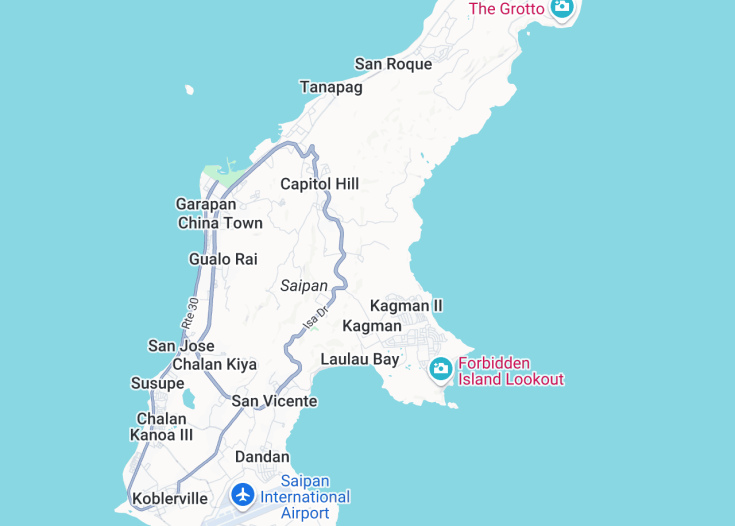Saipan, the largest of the Northern Mariana Islands, is a captivating destination known for its stunning beaches, historic World War II sites, and vibrant coral reefs. Its tropical climate and rich cultural heritage make it a perfect getaway for those seeking a blend of relaxation and adventure. Explorers can revel in outdoor activities like diving, hiking, and golfing, while history enthusiasts will appreciate visiting landmarks such as American Memorial Park and Last Command Post.
When visiting Saipan, pack reef-safe sunscreen to protect both your skin and the vibrant marine life you’ll encounter while snorkeling or diving in the pristine waters.
Consider scheduling your visit during the dry season from December to June for optimal weather conditions, maximizing your opportunities for outdoor excursions and events.
Top things to do & see in Saipan
Select the following sights and activities to discover best tickets and tours available in Saipan.
Saipan: Escape to Tranquility
| Country | Northern Mariana Islands (USA) |
| Time in Saipan | GMT+10 |
| Language spoken | English and Chamorro |
| Population | 52,000 (CIA World Factbook) |
| Currency | United States Dollar (USD) |
| Airports |
|
Saipan, the largest island of the Northern Mariana Islands, a commonwealth of the United States in the Pacific Ocean, is a compelling destination that offers both historical depth and stunning natural beauty. Known for its pivotal role during World War II, today Saipan blends its war relics with vibrant reefs, pristine beaches, and a diverse cultural heritage, making it an intriguing spot for history buffs and nature enthusiasts alike.
The island’s past is palpable at sites like the Last Command Post and the American Memorial Park, which honor the memory of those who fought in the Battle of Saipan. Meanwhile, Garapan, the island’s largest village, is a hub for shopping, dining, and cultural exploration.REOSRT
Ecotourism plays a crucial role in Saipan’s charm. The crystal-clear waters are perfect for snorkeling and scuba diving, particularly at Managaha Island, a small islet known for its protective reef. Bird Island Sanctuary offers another type of natural wonder, providing refuge for a variety of bird species within sight of breathtaking cliffs.
The Grotto, a collapsed limestone cave connected to the ocean, is one of the top diving spots in the world, noted for its stunning underwater caverns filled with sea turtles and reef sharks.
Culturally, Saipan is a melting pot, with indigenous Chamorro and Carolinian populations contributing to a rich tapestry of traditions, crafts, and dances. The annual Flame Tree Arts Festival showcases the island’s art and culture, drawing visitors and locals alike.
In addition to its cultural and natural attractions, Saipan offers a range of accommodations, from luxury resorts to more modest options, catering to all types of travelers seeking a peaceful getaway in the Pacific.
Where is Saipan?
Saipan is located in the western Pacific Ocean, part of the Mariana Islands archipelago, positioned north of Guam and east of the Philippines.
Distances:
| Route | Distance by car | Time by car |
|---|---|---|
| Garapan to Saipan International Airport | 8 miles | 15 minutes |
| Kagman to Mount Tapochau | 6 miles | 11 minutes |
What is Saipan famous for?
Saipan is known for its historical significance in World War II, stunning coral reefs, and vibrant marine life, making it a favorite destination for divers and history enthusiasts alike.
History
Ancient Period (Pre-1500)
The history of Saipan in the Northern Mariana Islands traces back to ancient times, when it was first inhabited by the Chamorro people over 2,000 years ago. These early settlers are believed to have arrived from Southeast Asia, navigating vast ocean distances with remarkable seafaring skills. The Chamorros developed a rich culture, closely tied to the sea and their environment, evolving distinct traditions, languages, and social structures over the centuries.
Spanish Era (1521-1899)
Following the arrival of European explorer Ferdinand Magellan in 1521, Saipan and the surrounding islands came under Spanish control. This period marked significant changes, including the introduction of Christianity, new governance structures, and a shift in cultural practices. However, it was also a time of hardship for the indigenous population, who faced diseases and conflicts that dramatically decreased their numbers.
German and Japanese Rule (1899-1945)
After Spain’s defeat in the Spanish-American War, Saipan was sold to Germany in 1899. The German administration invested in the development of copra (dried coconut) plantations, significantly transforming the island’s economy. However, this period was short-lived as Saipan fell under Japanese control after World War I. Under Japanese rule, Saipan became a sugar-producing hub, and its strategic location made it a focal point during World War II. The Battle of Saipan in 1944 was one of the most decisive battles of the Pacific War, resulting in heavy casualties and the eventual American victory.
Post-War and Modern Saipan (1945-Present)
Post-World War II, Saipan became a part of the Trust Territory of the Pacific Islands administered by the United States. In 1978, Saipan and the Northern Mariana Islands decided by referendum to become a Commonwealth of the United States. This new political status promoted development and modernization, although it also brought challenges, including debates over immigration, labor practices, and economic dependency on tourism. Throughout, Saipan has maintained a blend of its indigenous Chamorro culture with influences from its historical ties to Spain, Germany, Japan, and the United States.
Visit Saipan
What to see and do in Saipan, Northern Mariana Islands (USA)
Exploring Saipan offers a unique blend of natural beauty, rich history, and vibrant culture. Start your visit at the American Memorial Park, which pays homage to the soldiers and civilians who died during World War II. Dive into history at the Saipan Museum, home to artifacts that narrate the island’s diverse past from prehistoric times to modern day. For outdoor enthusiasts, Saipan’s pristine beaches, such as Managaha Island, are perfect for snorkeling, diving, and relaxing under the sun.










